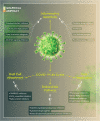Classification of the present pharmaceutical agents based on the possible effective mechanism on the COVID-19 infection
- PMID: 32734518
- PMCID: PMC7391927
- DOI: 10.1007/s40199-020-00359-4
Classification of the present pharmaceutical agents based on the possible effective mechanism on the COVID-19 infection
Abstract
Objectives: There are several types of research on the COVID-19 disease which have been conducting. It seems that prevailing over the pandemic would be achieved only by mastering over the virus pathophysiology. We tried to categorize the massive amount of available information for useful interpretation.
Evidence acquisition: We searched databases with different keywords and search strategies that focus on virulence and pathophysiology of COVID-19. The present review has aimed to gather and categorize all implemented drugs based on the susceptible virulence mechanisms, and the pathophysiological events in the host cells, discussing and suggesting treatments.
Results: As a result, the COVID-19 lifecycle were categorized as following steps: "Host Cell Attachment" which is mainly conducted with ACE2 receptors and TMPRSS2 from the host cell and Spike (S) protein, "Endocytosis Pathway" which is performed mainly by clathrin-mediated endocytosis, and "Viral Replication" which contains translation and replication of RNA viral genome. The virus pathogenicity is continued by "Inflammatory Reactions" which mainly caused moderate to severe COVID-19 disease. Besides, the possible effective therapeutics' mechanism and the pharmaceutical agents that had at least one experience as a preclinical or clinical study on COVID-19 were clearly defined.
Conclusion: The treatment protocol would be occasional based on the stage of the infection and the patient situation. The cocktail of medicines, which could affect almost all mentioned stages of COVID-19 disease, might be vital for patients with severe phenomena. The classification of the possible mechanism of medicines based on COVID-19 pathogenicity.
Keywords: COVID-19; Coronaviruses; Drug classification; Pandemic; Pharmaceutical agents; Possible treatments; SARS-CoV-2.
Conflict of interest statement
The authors have no conflict of interest to be declared.
Figures




Similar articles
-
SARS-CoV-2 attachment to host cells is possibly mediated via RGD-integrin interaction in a calcium-dependent manner and suggests pulmonary EDTA chelation therapy as a novel treatment for COVID 19.Immunobiology. 2021 Jan;226(1):152021. doi: 10.1016/j.imbio.2020.152021. Epub 2020 Nov 5. Immunobiology. 2021. PMID: 33232865 Free PMC article.
-
Testing the efficacy and safety of BIO101, for the prevention of respiratory deterioration, in patients with COVID-19 pneumonia (COVA study): a structured summary of a study protocol for a randomised controlled trial.Trials. 2021 Jan 11;22(1):42. doi: 10.1186/s13063-020-04998-5. Trials. 2021. PMID: 33430924 Free PMC article.
-
Contributions of human ACE2 and TMPRSS2 in determining host-pathogen interaction of COVID-19.J Genet. 2021;100(1):12. doi: 10.1007/s12041-021-01262-w. J Genet. 2021. PMID: 33707363 Free PMC article. Review.
-
Targeted therapy strategies against SARS-CoV-2 cell entry mechanisms: A systematic review of in vitro and in vivo studies.J Cell Physiol. 2021 Apr;236(4):2364-2392. doi: 10.1002/jcp.30032. Epub 2020 Sep 9. J Cell Physiol. 2021. PMID: 32901936
-
Targeting the viral-entry facilitators of SARS-CoV-2 as a therapeutic strategy in COVID-19.J Med Virol. 2021 Sep;93(9):5260-5276. doi: 10.1002/jmv.27019. Epub 2021 May 3. J Med Virol. 2021. PMID: 33851732 Free PMC article. Review.
Cited by
-
Intersections between pneumonia, lowered oxygen saturation percentage and immune activation mediate depression, anxiety, and chronic fatigue syndrome-like symptoms due to COVID-19: A nomothetic network approach.J Affect Disord. 2022 Jan 15;297:233-245. doi: 10.1016/j.jad.2021.10.039. Epub 2021 Oct 24. J Affect Disord. 2022. PMID: 34699853 Free PMC article.
-
Increased ACE2, sRAGE, and Immune Activation, but Lowered Calcium and Magnesium in COVID-19.Recent Adv Inflamm Allergy Drug Discov. 2022;16(1):32-43. doi: 10.2174/2772270816666220318103929. Recent Adv Inflamm Allergy Drug Discov. 2022. PMID: 35307003
-
Navigating the COVID-19 Therapeutic Landscape: Unveiling Novel Perspectives on FDA-Approved Medications, Vaccination Targets, and Emerging Novel Strategies.Molecules. 2024 Nov 25;29(23):5564. doi: 10.3390/molecules29235564. Molecules. 2024. PMID: 39683724 Free PMC article. Review.
-
A Systematic Review of the Global Intervention for SARS-CoV-2 Combating: From Drugs Repurposing to Molnupiravir Approval.Drug Des Devel Ther. 2022 Mar 15;16:685-715. doi: 10.2147/DDDT.S354841. eCollection 2022. Drug Des Devel Ther. 2022. PMID: 35321497 Free PMC article.
-
Confronting the threat of SARS-CoV-2: Realities, challenges and therapeutic strategies (Review).Exp Ther Med. 2021 Feb;21(2):155. doi: 10.3892/etm.2020.9587. Epub 2020 Dec 17. Exp Ther Med. 2021. PMID: 33456522 Free PMC article. Review.
References
-
- H. de Wilde A, al e. Host factors in coronavirus replication. inroles of host gene and non-coding RNA expression in virus infection. 2017;Springer, Cham.:1–42.
Publication types
MeSH terms
LinkOut - more resources
Full Text Sources
Research Materials
Miscellaneous

